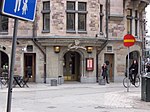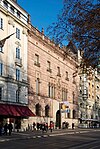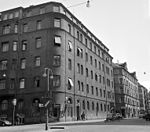Royal Dramatic Theatre

The Royal Dramatic Theatre (Swedish: Kungliga Dramatiska Teatern, colloquially Dramaten) is Sweden's national stage for "spoken drama", founded in 1788. Around one thousand shows are put on annually on the theatre's eight running stages. The theatre has been at its present location in the Art Nouveau building at Nybroplan, Stockholm, since 1908. The theatre was built by the architect Fredrik Lilljekvist. Famous artists like Carl Milles and Carl Larsson were involved in making the decorations, and some of the interior decorations were made by Prince Eugen. The theatre's acting school, the Royal Dramatic Training Academy, produced many actors and directors who would go on to be famous, including Gustaf Molander (who also taught there), Alf Sjöberg, Greta Garbo, Vera Schmiterlöw, Signe Hasso, Ingrid Bergman, Gunnar Björnstrand, Max von Sydow, and Bibi Andersson. The school was split off as a separate institution in 1967 (see Swedish National Academy of Mime and Acting).
Excerpt from the Wikipedia article Royal Dramatic Theatre (License: CC BY-SA 3.0, Authors, Images).Royal Dramatic Theatre
Nybroplan, Stockholm Östermalm (Östermalms stadsdelsområde)
Geographical coordinates (GPS) Address Website External links Nearby Places Show on map
Geographical coordinates (GPS)
| Latitude | Longitude |
|---|---|
| N 59.333333333333 ° | E 18.076944444444 ° |
Address
Dramaten
Nybroplan
102 41 Stockholm, Östermalm (Östermalms stadsdelsområde)
Sweden
Open on Google Maps










